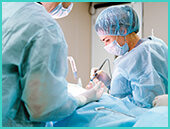We Provide Assistance in
Service Medical
Knee replacement, or knee arthroplasty, is a surgical procedure to relieve severe knee pain and improve function by replacing damaged knee joint surfaces with artificial components, allowing improved mobility and pain relief, commonly performed in cases of arthritis or joint damage.
Major Reasons for Knee Replacement Surgery
- Loosening and wear of implants
- Surgical site infection
- Joint instability
- Fractures
- Articular stiffness

When a patient is referred to a revision knee replacement program, the orthopaedic surgeon will recommend treatments based on the diagnosis, considering the patient's age, activity levels, and medical history. The assessment involves reviewing radiological, medical, physical, and historical records. Both non-surgical and surgical options are discussed with the patient during counselling and education.
Joint Revision knee replacement surgery is a complex procedure performed under general or regional anesthesia. It begins with an incision over the knee joint, often using the same incision as the initial surgery, followed by the careful dissection of tissues to access the joint. The surgeon then removes the old knee implant components, including the artificial joint and any cement with antibiotics in cases of infection. Afterward, they prepare the bone surfaces for the new components and securely insert and align the femoral, tibial, and patellar components. Soft tissues around the knee are repaired, and the incision is closed. Post-surgery, patients undergo a rigorous rehabilitation program to regain strength, flexibility, and knee function. Revision knee replacement surgery is more intricate than the initial procedure, typically necessitated by implant failure or complications from prior surgeries, with the ultimate aim of alleviating pain, restoring function, and enhancing mobility in the knee joint.

Once the decision to undergo revision knee replacement has been made, the orthopaedic surgeon will coordinate the surgical procedure. The process typically begins with the administration of anaesthesia, which can either be spinal or general, depending on the patient's specific requirements and the nature of the joint being replaced. Once the anaesthesia takes effect, the skilled surgical team goes to work, skillfully replacing the old knee implant components with a precisely tailored prosthesis. This transformative procedure offers hope to individuals suffering from joint-related issues, enabling them to regain their quality of life and enjoy a more comfortable and mobile future.

Essential Aspects of Recovery After Revision Knee Replacement Surgery
Postoperative care following revision knee replacement surgery consists of several essential components, including immediate and ongoing phases of rehabilitation.
- Immediate Postoperative Care
- Physical Therapy
Immediate Postoperative Care
In the immediate aftermath of revision knee replacement surgery, a pivotal phase of your recovery begins. During this period, medical professionals closely monitor your condition. They focus on effective pain management, wound care, and the initiation of gentle knee exercises.
Physical Therapy
Physical therapy is a cornerstone of your recuperation journey after revision knee replacement surgery. Collaborating with a licensed physical therapist, you'll embark on a personalized exercise program tailored to your unique needs. These exercises are specifically crafted to enhance knee flexibility, bolster strength, and expand your range of motion. Early exercises may encompass ankle pumps, gentle knee bends, and quad sets. Your physical therapist will guide you through each step, ensuring you progress safely and steadily.


